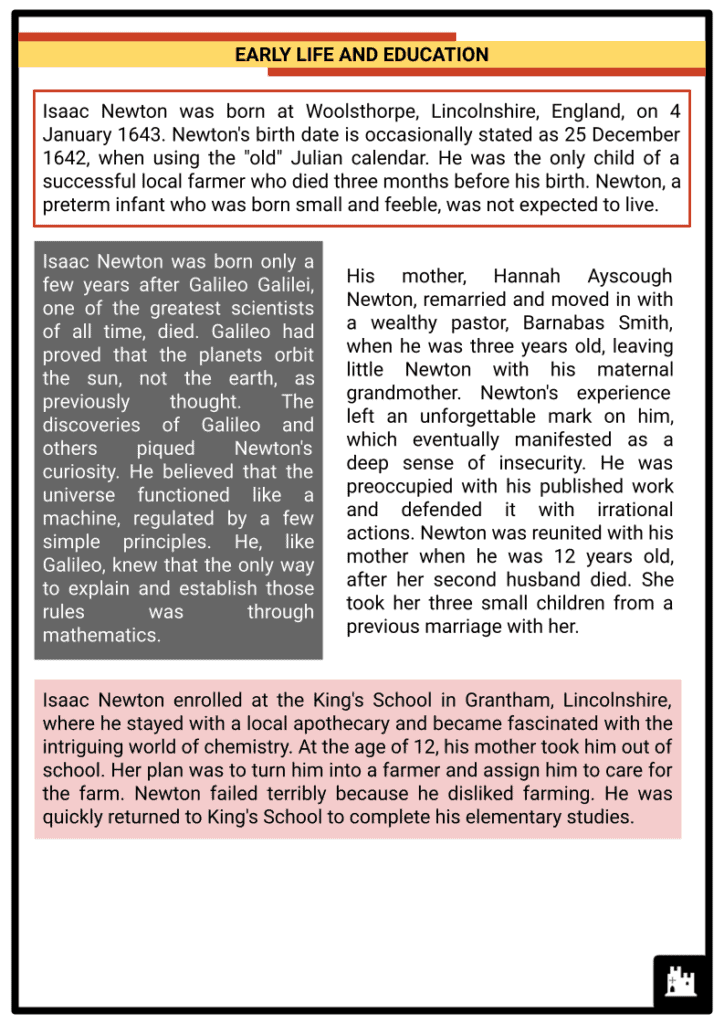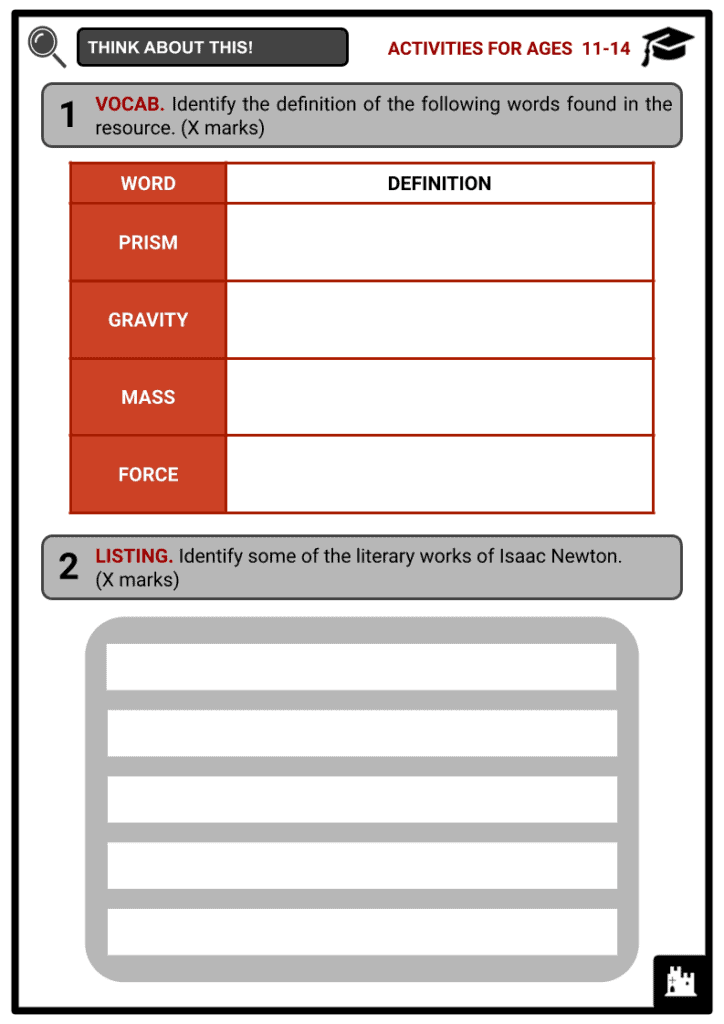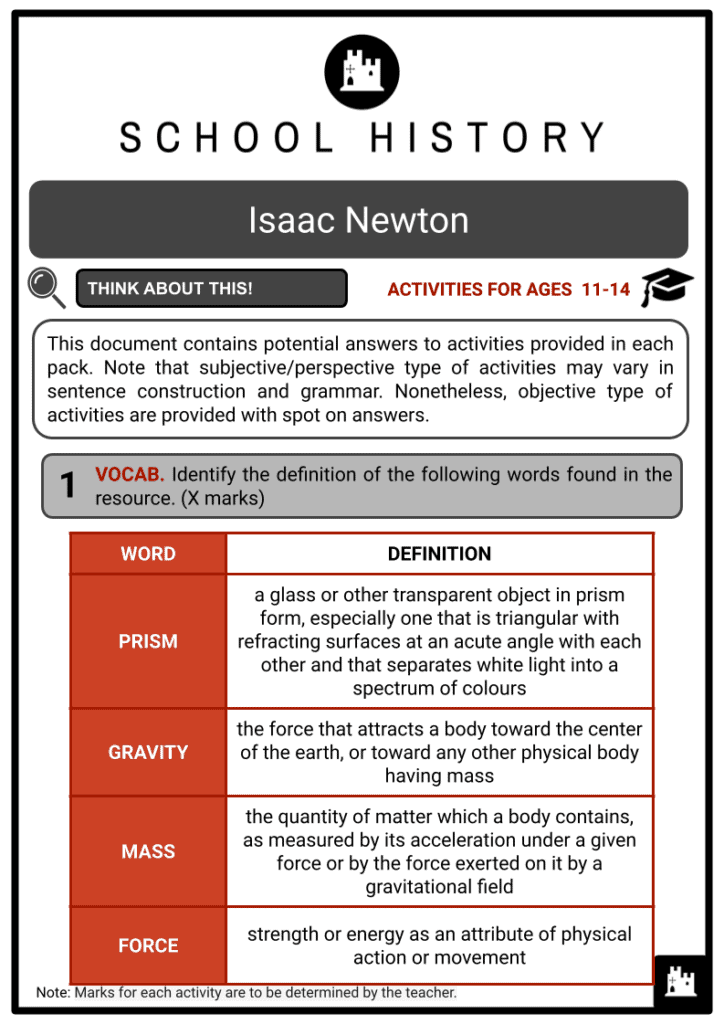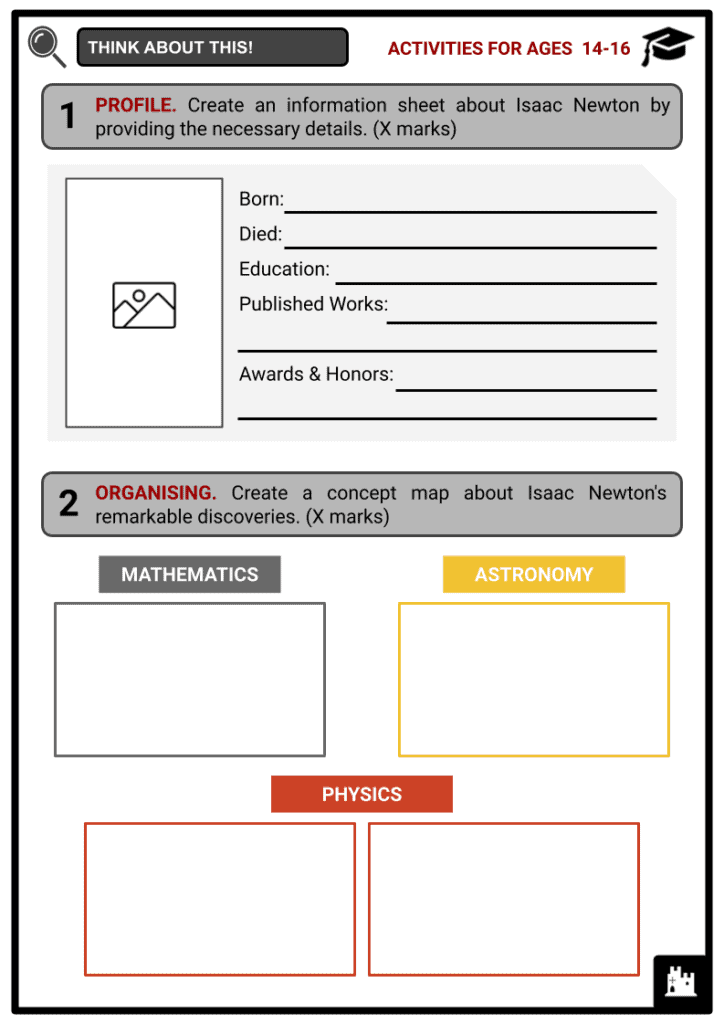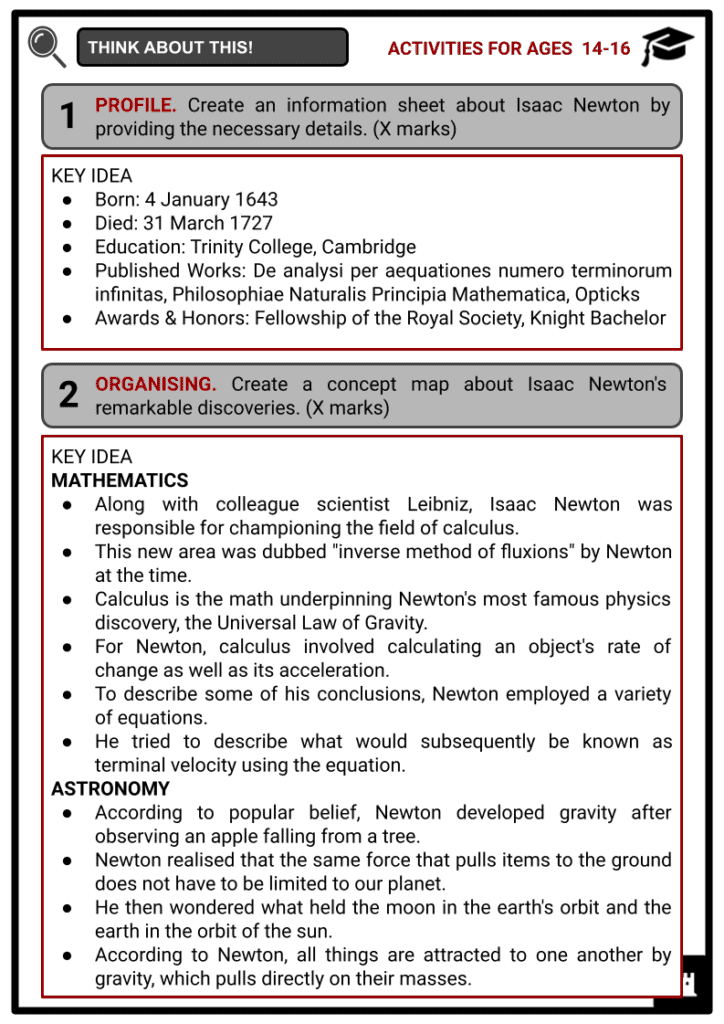Isaac Newton Worksheets
Do you want to save dozens of hours in time? Get your evenings and weekends back? Be able to teach about Isaac Newton to your students?
Our worksheet bundle includes a fact file and printable worksheets and student activities. Perfect for both the classroom and homeschooling!
Summary
- Early Life and Education
- Isaac Newton during the Scientific Revolution
- Discoveries and Inventions
- Death and Legacy
Key Facts And Information
Let’s find out more about Isaac Newton!
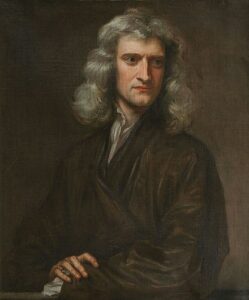
Isaac Newton was an English mathematician, physicist, astronomer, alchemist, theologian, and writer who is largely acknowledged as one of history's greatest mathematicians and physicists, as well as one of the most influential scientists. He is most known for his theory of gravity, his "Principia Mathematica", with its three laws of motion, which substantially impacted the Enlightenment in Europe, and he is regarded as one of the greatest brains of the Scientific Revolution in the seventeenth century. Newton also made significant contributions to optics, and he shares credit for establishing infinitesimal calculus with German mathematician Gottfried Wilhelm Leibniz.
EARLY LIFE AND EDUCATION
- Isaac Newton was born at Woolsthorpe, Lincolnshire, England, on 4 January 1643. Newton's birth date is occasionally stated as 25 December 1642, when using the "old" Julian calendar. He was the only child of a successful local farmer who died three months before his birth. Newton, a preterm infant who was born small and feeble, was not expected to live.
- Isaac Newton was born only a few years after Galileo Galilei, one of the greatest scientists of all time, died. Galileo had proved that the planets orbit the sun, not the earth, as previously thought. The discoveries of Galileo and others piqued Newton's curiosity. He believed that the universe functioned like a machine, regulated by a few simple principles. He, like Galileo, knew that the only way to explain and establish those rules was through mathematics.
- His mother, Hannah Ayscough Newton, remarried and moved in with a wealthy pastor, Barnabas Smith, when he was three years old, leaving little Newton with his maternal grandmother. Newton's experience left an unforgettable mark on him, which eventually manifested as a deep sense of insecurity. He was preoccupied with his published work and defended it with irrational actions. Newton was reunited with his mother when he was 12 years old, after her second husband died. She took her three small children from a previous marriage with her.
- Isaac Newton enrolled at the King's School in Grantham, Lincolnshire, where he stayed with a local apothecary and became fascinated with the intriguing world of chemistry. At the age of 12, his mother took him out of school. Her plan was to turn him into a farmer and assign him to care for the farm. Newton failed terribly because he disliked farming. He was quickly returned to King's School to complete his elementary studies.
- Newton studied a classical curriculum at Cambridge, but he grew attracted with modern philosophers such as René Descartes, dedicating a set of notes to his outside reads titled, "Quaestiones Quaedam Philosophicae." Newton went home when the Great Plague shut down Cambridge in 1665 and began forming his ideas on calculus, light, and colour, with his farm serving as the location for the alleged falling apple that inspired his work on gravity.
DURING THE SCIENTIFIC REVOLUTION
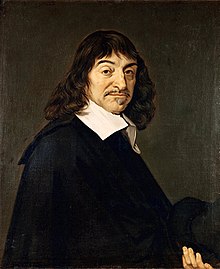
The Scientific Revolution of the 17th century was already in full force when Newton arrived in Cambridge. Most European academic circles were familiar with the heliocentric view of the cosmos, which was proposed by astronomers Nicolaus Copernicus and Johannes Kepler and subsequently revised by Galileo. René Descartes, a philosopher, began to create a new idea of nature as a complex, impersonal, and inert machine. Nonetheless, Cambridge, like other European colleges, was immersed in Aristotelian philosophy and a view of nature based on a geocentric world, dealing with nature qualitatively rather than quantitatively.
- Isaac Newton was taught the conventional curriculum during his first three years at Cambridge, but he was interested by the more advanced science. He spent all of his leisure time reading modern philosophers. As a result of his dual course of study, he had a less-than-stellar performance, which is reasonable.
- Newton kept a second collection of notes at this period, titled "Quaestiones Quaedam Philosophicae" ("Certain Philosophical Questions"). The "Quaestiones" show that Newton established a new view of nature that laid the foundation for the Scientific Revolution. He received the title of scholar and four years of financial support for future studies despite graduating without honours or distinctions.
- His wealth improved in the years that followed. Newton earned his Master of Arts degree in 1669, when he was just 27 years old. He came upon Nicholas Mercator's published work on strategies for dealing with infinite series around this period.
- Newton soon wrote ‘De Analysi’, a book in which he explained his own broader conclusions. He shared it with Isaac Barrow, a friend and mentor, but didn't credit him as author.
- Barrow gave the unaccredited text to British mathematician John Collins in June 1669. In August 1669, Barrow defined its author to Collins as, "Mr. Newton ... very young ... but of an extraordinary genius and proficiency in these things." For the first time, Newton's work was brought to the attention of the mathematical community. Barrow quit his Lucasian position at Cambridge shortly after, and Newton took over.
DISCOVERIES AND INVENTIONS
-
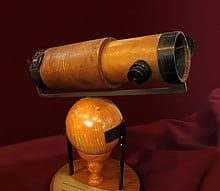
Reflecting Telescope Newton achieved breakthroughs in the fields of optics, motion, and mathematics. Newton proposed that white light was made up of particles and that it was composed of all the hues in the spectrum. His seminal physics work, Principia, covers practically all of the fundamental notions of physics, save energy, and finally aids him in explaining the laws of motion and the theory of gravity. Newton is credited with establishing basic theories of calculus, together with mathematician Gottfried Wilhelm von Leibniz.
- In 1671, the Royal Society requested a demonstration of Newton's reflecting telescope, and the society's enthusiasm prompted Newton to publish his notes on light, optics, and colour in 1672. These notes were later published as part of, ‘Newton's Opticks: Or, A treatise of the Reflections, Refractions, Inflections and Colours of Light’.
- Isaac Newton came home from Trinity College between 1665 and 1667 to resume his private studies when the institution was closed due to the Great Plague. He is said to have had his famous idea of gravity with the falling apple about this time. Newton was seated under an apple tree when a fruit fell and smacked him on the head, prompting him to come up with the idea of gravity, according to legend.
- While there is no proof that the apple struck Newton in the head, he did witness an apple fall from a tree and wondered why it fell straight down rather than at an angle. As a result, he began to study motion and gravity theories.
- Many of Newton's most important insights, such as the method of infinitesimal calculus, the foundations for his theory of light and colour, and the laws of planetary motion, were developed during his 18-month hiatus as a student, and eventually led to the publication of his physics book Principia and his theory of gravity.
- Newton published ‘Philosophiae Naturalis Principia Mathematica (Mathematical Principles of Natural Philosophy)’, more often known as Principia, in 1687, after 18 months of hard and practically non-stop effort. Principia is often considered to be the most significant book in physics, if not all of science. Its release boosted Newton to international fame almost instantly.
- With three fundamental but crucial laws of motion, Principia provides a precise quantitative description of bodies in motion:
- A stationary body will stay stationary unless an external force is applied to it.
- Force is equal to mass times acceleration, and a change in motion (i.e., change in speed) is proportional to the force applied.
- For every action, there is an equal and opposite reaction.
- Newton's idea of gravity was supported by the three basic laws of motion stated in Principia. According to Newton's law of universal gravitation, two objects are attracted to each other by a gravitational force proportional to their masses and inversely proportional to the square of the distance between their centers.
- These laws helped explain not only elliptical planetary orbits, but nearly every other motion in the universe, including how the sun's gravity keeps the planets in orbit; how the moon revolves around Earth and Jupiter's moons revolve around it; and how comets revolve in elliptical orbits around the sun.
- They also allowed him to calculate the mass of each planet, as well as the flattening and bulging of the Earth at the poles and equator, and how the sun and moon's gravitational pull generate the Earth's tides. Gravity, according to Newton, held the universe in balance, made everything operate, and brought heaven and Earth together in a single equation.
LEGACY AND DEATH
- Newton spent the latter years of his life with his niece Catherine (Barton) Conduitt and her husband, John Conduitt, at Cranbury Park, near Winchester, England. By this time, Newton had established himself as one of Europe's most well-known figures. His scientific findings were uncontested. He had also gained wealth by properly investing his substantial earnings and making significant charity donations.
- Newton's life was far from perfect, despite his fame: he never married or made many friends, and in his later years, a combination of pride, insecurity, and side journeys on strange scientific pursuits caused even some of his few acquaintances to be concerned about his mental health.
- Newton's digestion had become an issue by the time he was 80 years old, and he had to radically alter his diet and movement. Newton passed out in March 1727 after suffering acute abdominal pain and he never regained consciousness. He died the next day, at the age of 84, on 31 March 1727.
- Newton's fame soared even further after his death, with many of his contemporaries proclaiming him as the greatest genius of all time. Perhaps exaggerating a little, but his discoveries had a significant effect on Western thought, prompting comparisons to Plato, Aristotle, and Galileo.
- Newton's universal laws of gravity had no counterparts in science at the time, despite the fact that his discoveries were among many made during the Scientific Revolution.
"I do not know what I may appear to the world; but to myself I seem to have been only like a boy playing on the seashore, and diverting myself now and then in finding a smoother pebble or prettier shell than ordinary, while the great ocean of truth lay all undiscovered before me."
- Newton was, of course, proven incorrect on a number of fundamental assumptions. Albert Einstein would alter Newton's notion of the universe in the twentieth century, claiming that space, distance, and motion were not absolute, but relative, and that the universe was more amazing than Newton could have imagined.


